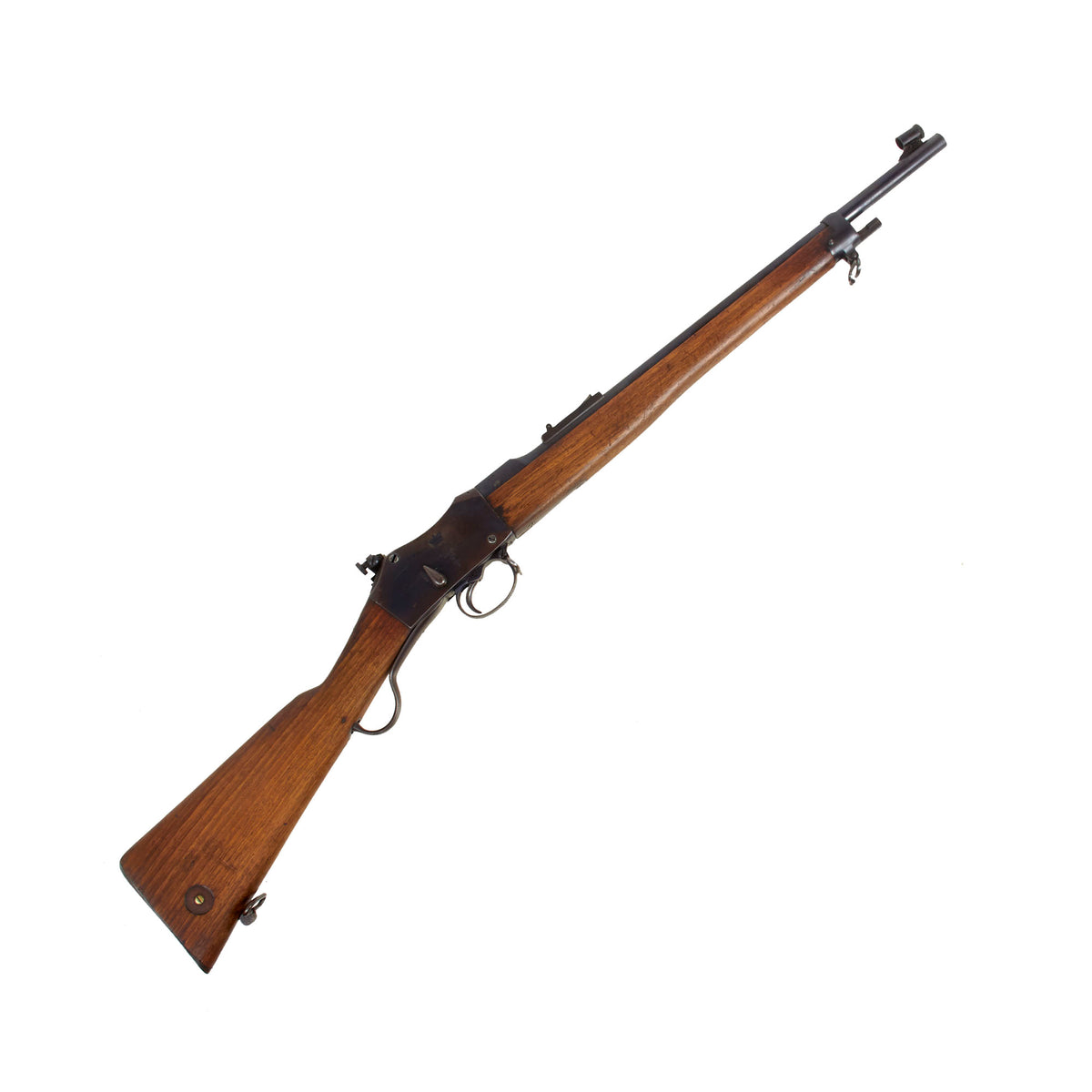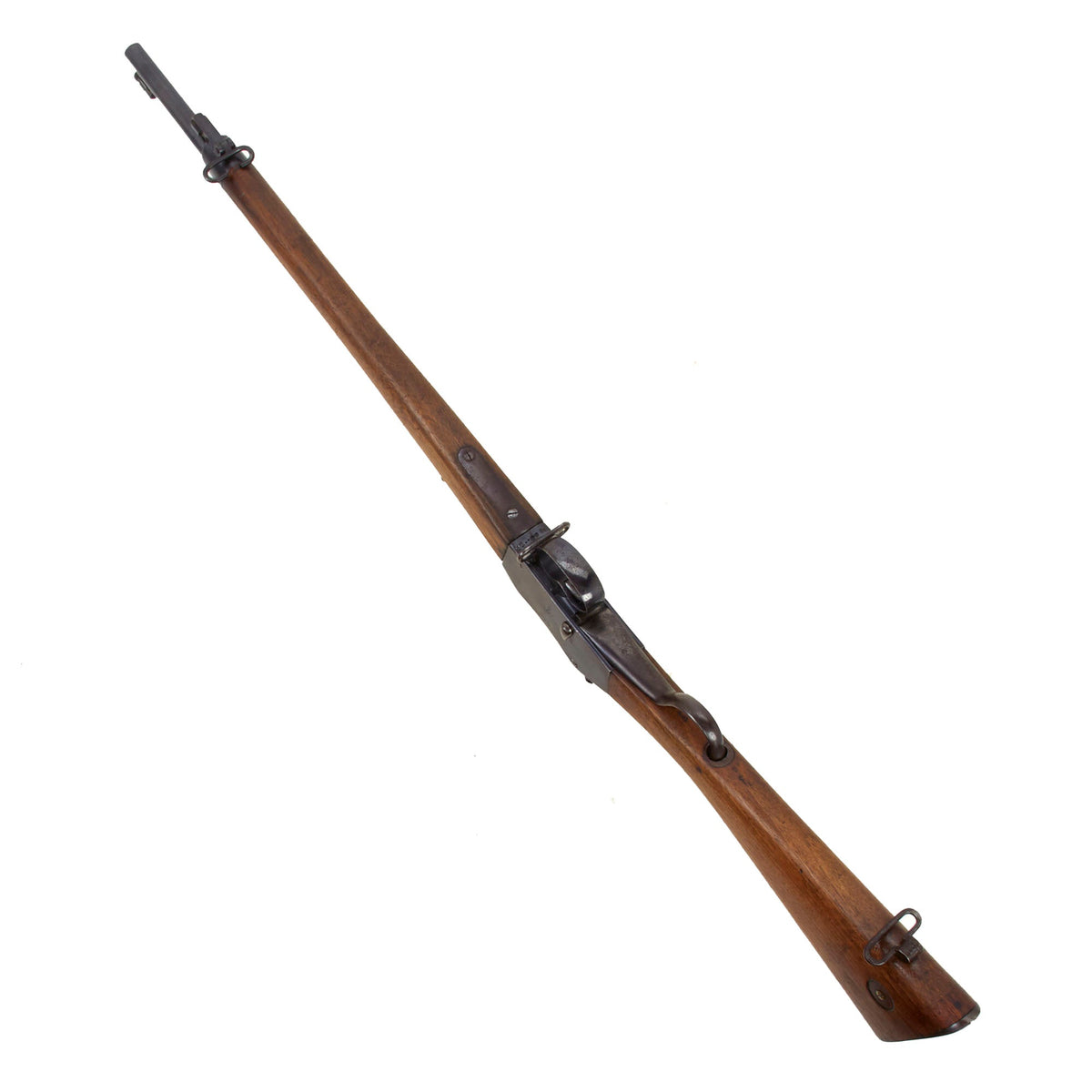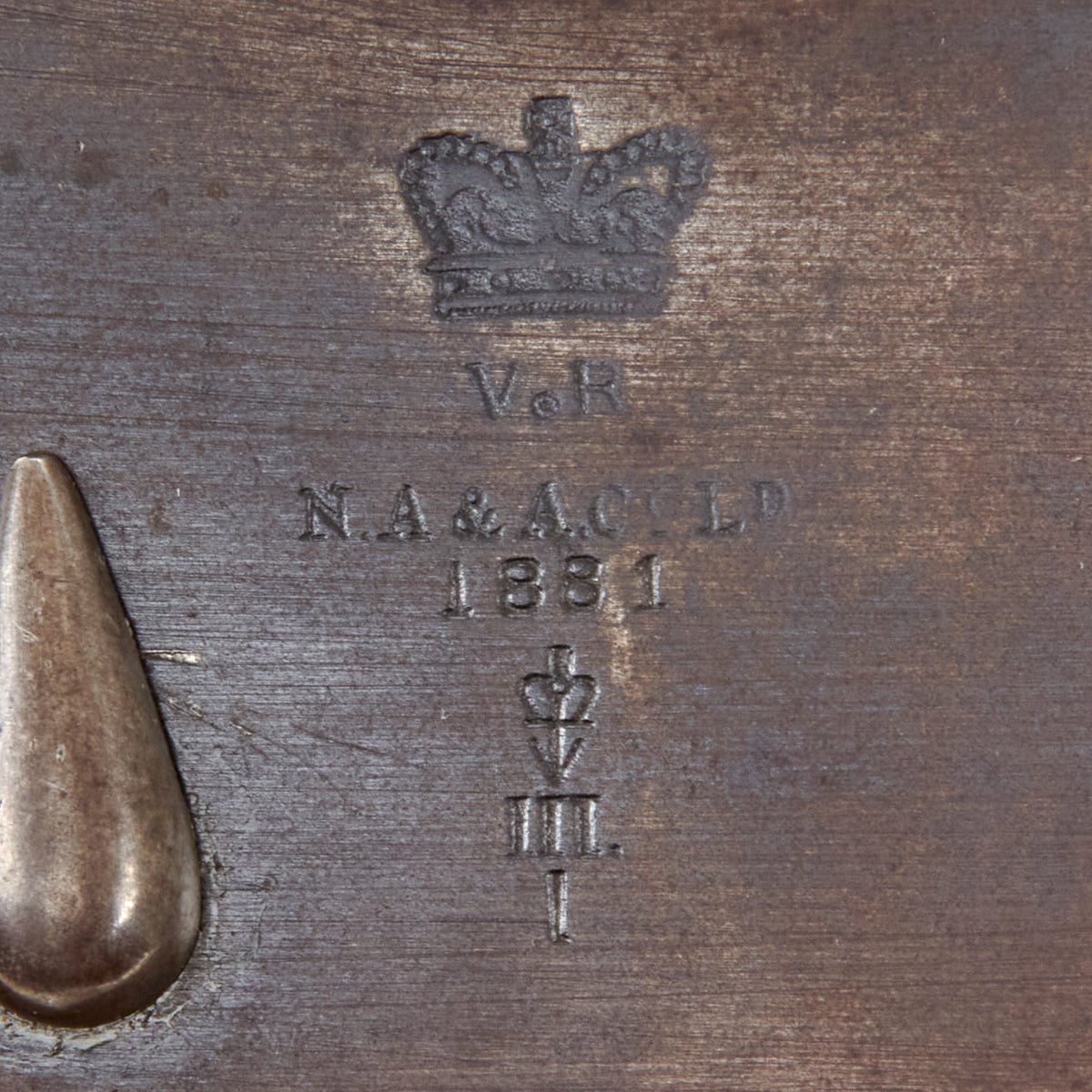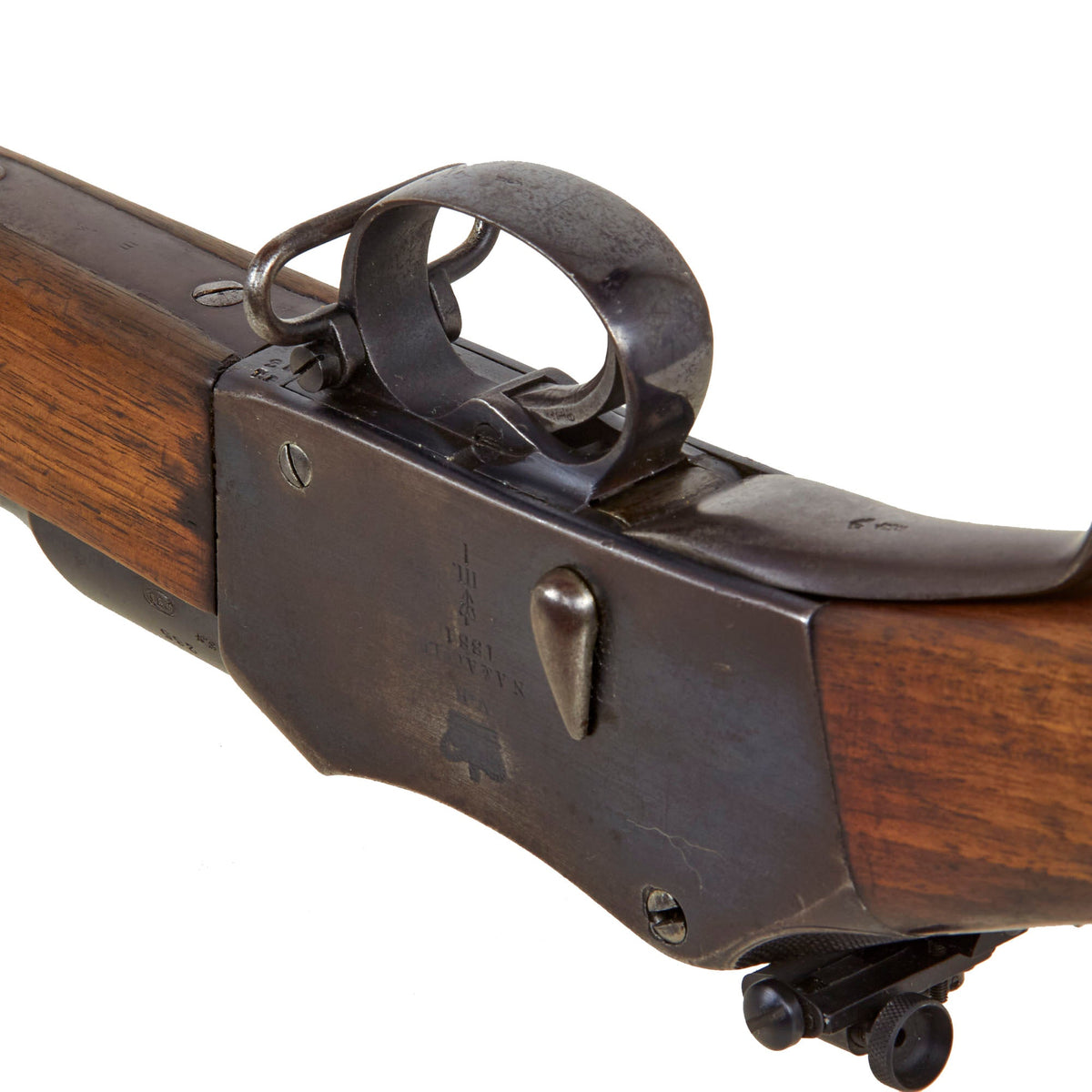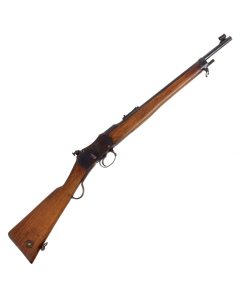Original British Martini-Metford A.C.III Artillery Carbine by N.A.&A. Co. Converted to .22 by Greener for the NRA – dated 1881 Original Items
$ 1.495,00 $ 373,75
Original Item: Only One Available. Well this is definitely a firearm that has seen quite a bit of history during it’s long life! Shortened from a rifle to a carbine and converted to a new caliber not once but TWICE! The markings on the metalwork of the gun help trace its very interesting history.
The Martini-Metford was effectively a Martini-Henry Mk III rebarrelled to .303 and with a new extractor installed. These conversions started in 1889, and used Metford rifled barrels, which were more than suitable for the first .303 cartridges, which used black powder as a propellant. However, the Metford rifling wore out very quickly when fired with cordite/nitrocellulose cartridges (introduced in 1895) and so in 1895 the Enfield rifled barrel was introduced, which was much more satisfactory and suitable for use with “modern” (smokeless) ammunition. Only produced for a limited time, these were essentially only service from 1889 to 1895, and were quickly supplanted by the Martini-Enfield for colonial forces, which makes them quite rare to find.
In the first half of the 20th Century, the National Rifle Association worked with W.W. Greener to convert and import now obsolete Martini Action rifles to .22lr for use as training rifles, often used by the military. This involved a second replacement of the barrel, as well as changes to the breech block and ejector to work with the small rimfire cartridges.
On these converted Martini-Henry rifles, the original manufacturer information would be stamped onto the right side of the action, while the left side would have information regarding the conversion. This example is marked on the right action with original maker information, which has had the Royal Cypher wear away, while the rest is still legible:
(Crown)
V.R.
N.A.&A.Co.Ld.
1881.(Lock Viewer Mark)III.
1
The left side is marked with the conversion information for both conversions:
(Crown)
V.R.
CONVERTED FOR THE N.R.A. BY W.W. GREENER
ENFIELD
1894
(Lock Viewer Mark)
M.M.’303
A.C. III
This started life in England as a .577/.450 Martini MARK III in 1881, made by government contractor National Arms and Ammunition Company Ltd., just in time for the Egyptian campaign and the Battle of Tel-el-Kabir in 1884. In 1895, this time at The Royal Small Arms Factory (RSAF) at Enfield Lock in England, it was reconfigured into a Carbine and was converted to .303 caliber as a Martini-Metford A.C. III Artillery Carbine.
It was then at some point sent to W.W. Greener, a well-known sporting gun manufacturer that still exists today, and was converted to .22lr for training, before being imported into the United States. They marked it just under the royal cypher on the right side. This carbine saw some additional modification, as the original front and rear sights were replaced with a recent front globe sight and rear peep sight by LYMAN, and the original rear sight leaf was removed.
The action cycles correctly with a crisp dry fire, though we have not tested it for any ability to eject cartridges. We checked the bore, and there is rifling present, but it definitely saw much use after being converted to a training rifle. There is wear and some past oxidation and fouling present in the grooves.
A wonderful piece of British and Firearms history! An antique, already over 135 years old and ready to research and display!
The Martini action, adopted by the British in 1871 was one of the strongest ever developed and saw military service in England and the Empire, in one form or another for almost seventy years. The most famous action of course being the defense of Rorke’s Drift in Natal, South Africa in the 1879 Zulu War. They saw extensive use all over the British Empire.
Specifications-
Year of Manufacture: 1881 – converted to .303 in 1894 and later to .22
Caliber: .22lr
Cartridge Type: Centerfire Cartridge
Overall Length: 21 1/4 Inches
Overall Length: 37 1/2 Inches
Action type: Falling-Block
Feed System: Single Shot
Fast Shipping with Professional Packaging
Thanks to our longstanding association with UPS FedEx DHL, and other major international carriers, we are able to provide a range of shipping options. Our warehouse staff is expertly trained and will wrap your products according to our exact and precise specifications. Prior to shipping, your goods will be thoroughly examined and securely secured. We ship to thousands clients each day across multiple countries. This shows how we're dedicated to be the largest retailer on the internet. Warehouses and distribution centres can be located throughout Europe as well as the USA.
Note: Orders with more than one item will be assigned a processing date depending on the item.
Before shipping before shipping, we'll conduct a thorough inspection of the items you have ordered. Today, the majority of orders will be delivered within 48 hours. The delivery time will be between 3-7 days.
Returns
The stock is dynamic and we cannot completely manage it because multiple stakeholders are involved, including our factory and warehouse. So the actual stock may alter at any time. It's possible that you may not receive your order once the order has been made.
Our policy is valid for a period of 30 days. If you don't receive the product within 30 days, we are not able to issue a refund or an exchange.
You can only return an item if it is unused and in the same state as the day you received it. You must have the item in its original packaging.
Related products
Uncategorized
Uncategorized
Uncategorized
Uncategorized
Uncategorized
Angolan Rebel 1970s era 60mm Inert Display Mortar from Angolan Civil War Original Items
Uncategorized
Uncategorized
Uncategorized
Uncategorized
Uncategorized
Uncategorized
Uncategorized
Uncategorized
Uncategorized
Uncategorized
Uncategorized
Uncategorized
Armoured Fighting Vehicles of the World: AFVs of World War One (Hardcover Book) New Made Items
